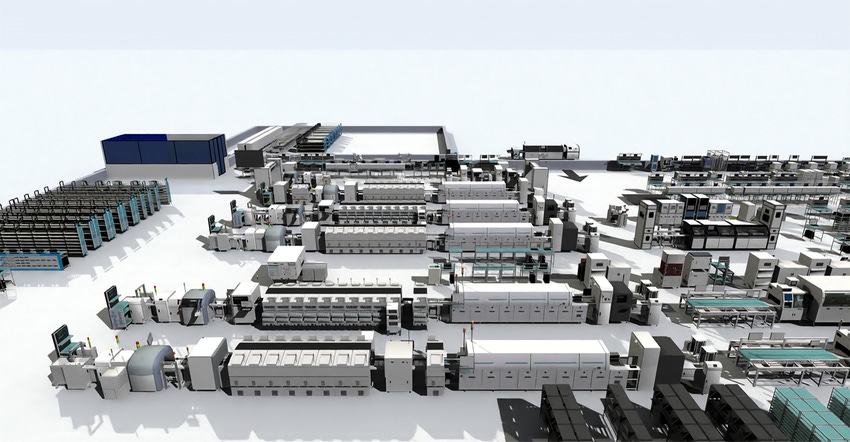Why You Should Adopt a Digital Twin
As with any newer technology entering a mature industry, deployment can be challenging, but the benefits can be substantial.
February 1, 2023

Digital twin technology has been around for a long time under various guises. Depending on the source, it first surfaced during WWII or later through NASA’s space program, but it has recently received a great deal of attention in the manufacturing realm. Headlines have called it a “game changer” and a new tool to "reinvent" the manufacturing process. Meanwhile, industry tends to be leery of a shiny new toy requiring substantial investment, and the rank and file wonder if this is one more unnecessary change agent ready to disrupt their work flow for dubious results. To get an expert’s perspective on digital twin technology, PlasticsToday checked in with Zohair Mehkri, Director of Engineering at Silicon Valley–based Flex, a design and manufacturing partner to global OEMs. Mehkri is scheduled to speak at the co-located Plastec West and Medical Design & Manufacturing (MD&M) West event in Anaheim, CA, on Feb. 7 on the use of digital twins in medical design and manufacturing.
|
Zohair Mehkri, Director of Engineering, Flex. |
Mehkri describes the digital twin as a closed-loop, bi-directional, cyber-physical system. “That’s a mouthful, though,” he acknowledged. In layperson terms, he added, “a digital twin replicates a real-world asset and connects a physical and virtual realm in real time.” Mehkri went on to explain the relationship of the digital twin with discrete event simulation (DES), which Flex uses to fully leverage the technology.
Simulation can, and does, exist without a digital twin, Mehkri noted, but you can’t have a digital twin without simulation. That’s where DES comes in. “Every physical environment is made up of space, time, and matter. DES models those three categories in a virtual capacity,” said Mehkri. “Once you connect DES to databases, physical systems, and other IT and OT technology and have data and communication flowing back and forth, you enter the world of digital twins.”
In his presentation at Plastec/MD&M West, Mehkri will present the benefits of a digital twin in the medical design and manufacturing space. As noted in the session description, the technology provides insights into an environment while it is still in the planning stage and can predictively answer “what-if” questions, affecting the timing, cost, and quality of a medical product. But, he added, most businesses, including plastics processing, will find value in digital twin technology.
“The processes used to form plastics are very calculated steps that are functions of chemistry and time,” Mehkri told PlasticsToday. “When you use simulation and digital twins to model processes, you can figure out the most efficient way forward.” Flex frequently uses simulation and digital twins to model its plastics processing operations, said Mehkri, who offered one example.
It’s very helpful “when we’re looking at how many plastic parts we have to mold over a given time to meet a specific demand,” said Mehkri. “For instance, if we need to produce a million units every six months, the technology helps model mold capacity to see how much space, time, machines, materials, and people we need.”
As with any newer technology entering a mature industry, adoption can be challenging. Business owners, for instance, may be doing it for the wrong reasons or have inflated expectations. There may be a technology for technology’s sake mindset driving digital twin implementation, recognized Mehkri. “Digital twin implementation must align with business objectives. Organizations need to consider how digital twins can help drive efficiency and operations early in the process,” said Mehkri.
Leveraging the massive amount of data collected by a digital twin to drive innovation may also be a challenge. Meaningful implementation requires serious streamlining, according to Mehkri. “Companies need to be open to managing gaps in data and take steps to build on existing assets to return real value. Machine learning and artificial intelligence have proven to be helpful in these instances,” said Mehkri.
Buy-in from employees can also be an obstacle, but that’s a barrier with any new technology, noted Mehkri. The potential benefits speak for themselves: When a process or an entire factory, is modeled, simulated, and analyzed, manufacturers can save up to 70% of the time, maximize operations by increasing efficiency up to 20%, and streamline project management by increasing utilization by up to 15%, according to the Plastec/MD&M session description.
Thoughtful, expert-driven implementation is key to overcoming these and other barriers, according to Mehkri, and that is Flex’s forte. “We’ve done it for so long that we understand the challenges and know how to deal with issues that arise,” he told PlasticsToday. “We understand what the technology is — and what it isn’t. Having optimized hundreds of models, we have a ton of data that helps us set baselines across operations in various industries. Applying AI to the broad dataset and information help us compare, contrast, and make inferences about digital twins that surpass the capabilities of most companies,” said Mehkri.
If you are attending Plastec West/MD&M West, you can put Mehkri’s claims to the test. His presentation, “Digital Twins in Medical Design and Manufacturing,” is scheduled for 10:15 a.m. on Tuesday, Feb. 7, at Center Stage. The event itself runs from Feb. 7 to 9 at the Anaheim Convention Center in Anaheim, CA.
About the Author(s)
You May Also Like





